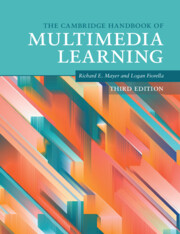Book contents
- The Cambridge Handbook of Multimedia Learning
- The Cambridge Handbook of Multimedia Learning
- Copyright page
- Contents
- Figures
- Tables
- Contributors
- Preface
- Acknowledgments
- Part I Background
- 1 Introduction to Multimedia Learning
- 2 Foundations of Multimedia Learning
- 3 Fifteen Common but Questionable Principles of Multimedia Learning
- 4 Research Methods in Multimedia Learning
- Part II Theoretical Foundations
- Part III Basic Principles of Multimedia Learning
- Part IV Principles for Reducing Extraneous Processing in Multimedia Learning
- Part V Principles for Managing Essential Processing in Multimedia Learning
- Part VI Principles Based on Social and Affective Features of Multimedia Learning
- Part VII Principles Based on Generative Activity in Multimedia Learning
- Part VIII Multimedia Learning with Media
- Author Index
- Subject Index
- References
2 - Foundations of Multimedia Learning
from Part I - Background
Published online by Cambridge University Press: 19 November 2021
- The Cambridge Handbook of Multimedia Learning
- The Cambridge Handbook of Multimedia Learning
- Copyright page
- Contents
- Figures
- Tables
- Contributors
- Preface
- Acknowledgments
- Part I Background
- 1 Introduction to Multimedia Learning
- 2 Foundations of Multimedia Learning
- 3 Fifteen Common but Questionable Principles of Multimedia Learning
- 4 Research Methods in Multimedia Learning
- Part II Theoretical Foundations
- Part III Basic Principles of Multimedia Learning
- Part IV Principles for Reducing Extraneous Processing in Multimedia Learning
- Part V Principles for Managing Essential Processing in Multimedia Learning
- Part VI Principles Based on Social and Affective Features of Multimedia Learning
- Part VII Principles Based on Generative Activity in Multimedia Learning
- Part VIII Multimedia Learning with Media
- Author Index
- Subject Index
- References
Summary
Mayer’s Cognitive Theory of Multimedia Learning (CTML) specifies on a cognitive level how learning from multimedia instructional messages takes place and has produced many instructional principles that can be used to strengthen learning from multimedia. In this chapter, we explore the historical foundations of the CTML in cognitive psychology and in the field of instructional design. More specifically, we discuss three foundational theories to which the CTML is related that provide a strong theoretical and empirical basis for its cognitive and instructional principles and processes. These theories are Alan Baddeley and Graham Hitch’s multistore model of memory, Allan Paivio’s dual coding theory, and John Sweller’s theory of cognitive load. We introduce these theories as they existed at the time the development of the CTML started, and discuss how they are connected to Mayer’s CTML. In addition to discussing the theoretical connections, we also discuss differences between the foundational theories and the CTML and recent developments in these theories.
Keywords
- Type
- Chapter
- Information
- The Cambridge Handbook of Multimedia Learning , pp. 17 - 24Publisher: Cambridge University PressPrint publication year: 2021
References
- 2
- Cited by



